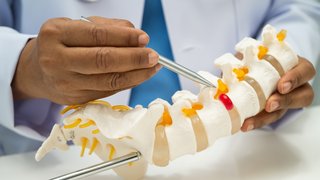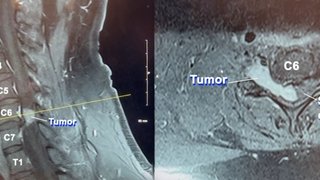Got a bad back? Exercise could be the key to relieving pain
January 16, 2020

Spinal discs are like shock absorbers for your back. And, like the rest of our bodies, these discs naturally begin to wear down with use and age. If disc degeneration is seen on an X-ray or MRI, this process is often labeled as degenerative disc disease (DDD). Despite what the name suggests, it’s not considered a true disease, nor does it necessarily worsen over time.
When diagnosing low back pain, it is important to determine whether DDD is the cause or just natural aging seen on imaging.
At the Spine Center at UT Southwestern Frisco, we investigate every potential cause of a patient's back pain, from aging and stress to sedentary lifestyle and spine conditions such as DDD. We then create an individualized and customized treatment plan based on each patient’s condition.
Approximately 80% to 90% of the population will experience an episode of back pain in their lifetime, and most cases will resolve within four to six weeks. Furthermore, patients often are surprised that, for nonspecific back pain with no neurological symptoms, exercise can be one of the best treatments.
However, once a patient believes they have a "bad back" due to aging or DDD, they often tell us they feel compelled to move less and sit more.
'If my back hurts, why would I exercise?'
Staying sedentary increases stiffness and decreases flexibility, which can lead to more pain. People who limit their movement can also develop weakness in the muscles of the abdomen, buttocks, hamstrings, and thighs that support the spine, which can further exacerbate their pain.

On the other hand, exercise increases blood flow, which carries oxygen and nutrients to the back muscles and tissues, promoting healing. Exercise can also create a positive hormonal response in the body as it increases endorphins that can potentially have a natural analgesic effect.
Mind-body exercises such as yoga or tai chi have been found to improve chronic low back pain and reduce the need for medications. So, even if the natural tendency is to rest, exercise will likely benefit patients with nonspecific back pain.
I encourage patients to find a range of activities they enjoy and incorporate them into their routines. Start with walking 10 minutes a day, then work up to 30 to 40 minutes a day, four or five times a week. After your walk, spend a few minutes performing spine stretching exercises.
Then add strength training, such as body squats, using resistance bands, and yoga to strengthen the muscles in your arms and legs as you become more limber. If you are not sure how to start a strength training routine, working with a physical therapist is a great way to learn how to properly perform exercises that will benefit your back pain and overall health.
Related reading: Updated treatment recommendations for lower back pain
The good news is that the majority of patients with back pain will not need surgery. Along with exercise, some patients find that taking a short course of non-steroidal anti-inflammatory (NSAIDs) medications such as ibuprofen or naproxen helps alleviate acute (short-term) back pain. Others find that making lifestyle changes such as meditation, deep breathing exercises, eating a healthier diet, and quitting smoking helps relieve symptoms.
Comprehensive spine care
The team at UT Southwestern includes orthopedic and neurological specialists, along with physical medicine and rehabilitation doctors. Together, they provide patients with the best multidisciplinary care to improve their back pain and spine conditions.
When to see a doctor
In general, if your pain goes away when you lie down for bed, that's a good sign. But if it keeps you awake or if daytime pain persists for more than four to six weeks, that warrants a trip to the doctor.
The nerves that control the arms and legs are located in the neck and spine, and symptoms related to the nervous system are considered a medical emergency. See your doctor right away if you experience any of these red-flag symptoms:
- Bowel or bladder incontinence
- Recurrent fevers or night sweats
- Loss of balance
- Numbness or tingling in the arms or legs
- Shooting pain in the legs
- Unexplained weight loss
- Weakness in the arms or legs
Degenerative disc disease and acute back pain can cause quality of life issues, but both are surmountable with expert care. If you've been diagnosed with a "bad back" or spinal degeneration condition, we welcome you to come see us – in person or virtually. Our spine experts will review your symptoms, imaging, and previous diagnoses as a team. Together, we'll determine the root of your back pain and whether you need advanced care to help you get on track to recovery.
If you prefer to be seen in person, call 469-604-9140 or schedule an appointment online.
For Texas residents, our spine clinic offers a remote, secure online second opinion program for a flat fee.










